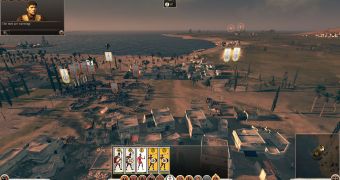I have talked a lot about the strategic options that Total War: Rome II is offering, but the heart of the new title from The Creative Assembly still lies with the tactical battles, those beautiful moments when armies meet and men clash, bleed and kill each other for a few meters of land.
The engagements are bigger this time around because the entire game encourages the creation of larger armies that can take cities, hold them while they are reinforced and then move on to other targets or go in a defensive stance.
The general and even lowlier units also have a number of special abilities that can make a big difference on the battlefield as long as they are used correctly, even if they first sound trivial.
It’s crucial to try and envelop the flanks of the enemy as long as you have the troops and the numbers to do it or at least make the battle as unfair as possible by using the terrain and the weather to your advantage.
My impression is that long-range harassment using bows and slings is more important than before and that close-range skirmishers are less important than in the first Rome.
Positioning is also crucial for good battle performance, especially when dealing with the hoplites and the phalanxes of the Greek and Successor factions, as is knowing exactly when to activate their unique abilities.
There’s less cavalry on the battlefield than I was used to, but its impact can be even bigger when it hits from the back in a classic hammer and anvil move.
The battles in Total War: Rome II are faster than in the original even before the speed controls are used, which some longtime players might not like, but given the scope of the game and the limited time I have to engage with it, I can tolerate the change.

 14 DAY TRIAL //
14 DAY TRIAL //